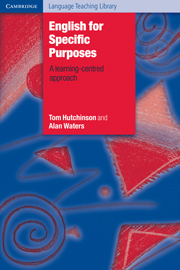Introduction
Published online by Cambridge University Press: 03 May 2010
Summary
To travel hopefully is a better thing than to arrive, and the true success is to labour.
(Robert Louis Stevenson)The City of ELT
Once upon a time there was a city called ELT. The people of ELT led a comfortable, if not extravagant, life, pursuing the noble goals of literature and grammar. There were differences, of course: some people preferred to call themselves EFL people, while others belonged to a group known as ESL. But the two groups lived in easy tolerance of each other, more united than disunited.
Now it happened that the city was surrounded by high mountains and legend had it that the land beyond the mountains was inhabited by illiterate and savage tribes called Scientists, Businessmen and Engineers. Few people from ELT had ever ventured into that land. Then things began to change. Some of the people in ELT became restless. The old city could not support its growing population and eventually some brave souls set off to seek their fortune in the land beyond the mountains. Many in ELT were shocked at the prospect. It was surely no place for people brought up in the gentle landscape of English literature and language.
But, as it turned out, the adventurers found a rich and fertile land. They were welcomed by the local inhabitants and they founded a new city, which they called ESP. The city flourished and prospered as more and more settlers came. Soon there were whole new settlements in this previously uncharted land. EST and EBE were quickly followed by EAP and EOP (the latter confusingly also known as EVP and VESL).
- Type
- Chapter
- Information
- English for Specific Purposes , pp. 1 - 4Publisher: Cambridge University PressPrint publication year: 1987
- 1
- Cited by

